Tunisian Crochet Quick is gaining popularity among craftswomen, thanks to simple patterns, unusual designs, and the ability to obtain an even and dense fabric.
Basics of Tunisian Crochet
Despite the name, which indicates that this type of knitting belongs to Tunisia, the same technique was used by needlewomen in Afghanistan and women in medieval England, France, Italy and Spain. Therefore, it is not known for certain where Tunisian knitting appeared and when.
Knitters know that when knitting with a regular crochet hook, the yarn consumption is higher than, for example, when knitting with knitting needles. Tunisian crochet, on the contrary, allows you to save up to 20% of threads.
The fabric in Tunisian crochet is very dense, which distinguishes it from other techniques when creating bags, blankets, rugs and outerwear. When washing and wearing, the knitted item does not stretch, which means that the sleeves of sweaters or coats do not need to be reinforced with a lining.
Items made using threads of different colors in the jacquard style look especially impressive.
If the idea is to decorate the item with cross-stitch or beadwork, then Tunisian patterns are ideal for such decoration.
To work you need a special hook, which is different from the usual one, it is longer.
Knitting is done only from the front side. There is no need to turn the item when moving to the next row.
Since the knitting itself is dense, special attention should be paid to the tension of the thread. The thread should have medium or weak tension. It is recommended to knit a 10 cm by 10 cm sample before starting work on the product to determine the yarn consumption and practice the tension.
What you need to know about Tunisian crochet?
Tunisian crochet, the patterns of which can be frightening for an unprepared needlewoman, is actually quite easy to master.
Hook
Tunisian crochet requires a special type of hook. Its length can be from 35 to 45 cm, it looks like a long knitting needle, on one side of which there is a hook, and on the other a special lock. The role of the lock is to prevent the loops from slipping off the hook during work.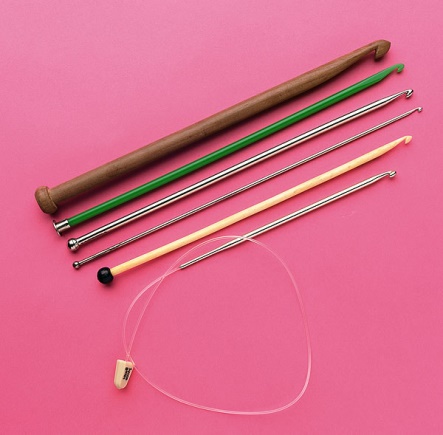
If the knitting is wide enough to fit on the hook, it should be replaced with a hook with a fishing line. In addition, models with a fishing line are usually longer than standard hooks (15-20 cm) and some needlewomen are more accustomed to knitting with them.
In addition, Tunisian crochet uses a double-ended hook, which has a rounded head on both sides. It is used when the product consists of several colors, or for knitting in a circle. For larger diameter items, it is convenient to use two hooks connected by a fishing line.
Regardless of the material the hook is made of, it should be flat and smooth.
The size of the Tunisian hook corresponds to its diameter. Since the knitting is very dense, when choosing a hook, you should focus on the thickness of the yarn. It is desirable that it is 2 times thicker than the yarn.
Yarn
There is no unsuitable yarn for Tunisian knitting. Since any knitted product is able to hold its shape well, even such difficult threads as, for example, viscose and bamboo, which are easily stretched already during the first wash and deformed during wear, are suitable.
On the other hand, it is necessary to carefully select models and products that will use coarse and already dense yarn. Such threads are best used in the manufacture of home interior items or bags.
Technique
In Tunisian crochet, each row actually consists of 2 rows. The first is knitting loops directly from the loops of the lower row. The work is done from right to left. Then, without unfolding the fabric, a row is made with a hook, in which the loops are secured. This conditional row should be done from left to right.
Any work on a product begins with knitting air loops (AL). It is necessary to remember that in the diagrams this chain is usually not indicated as 1 row.
The last row is also always the same. It consists of a single crochet (SC), which can be replaced with half crochets (HS). It is performed from right to left, after which the thread is cut and secured.
Tunisian crochet in straight and reverse rows
Tunisian crochet (patterns for forward, reverse or circular crochet are described further in the article) is always done according to the same pattern. First, the loops are cast on. Then, in the same row, the loops are secured until only one loop remains. This allows the thread to be secured first in the horizontal plane of the product, and then in the vertical. The result is a dense knitted fabric.
Performing straight knitting:
- It is necessary to knit a chain consisting of VP. The last loop will serve to move to the second row.
- Without changing the knitting position, you should cast on the loops on the hook. The first loop of the cast on should go through the penultimate VP. The resulting loops do not need to be knitted. They should remain on the hook.
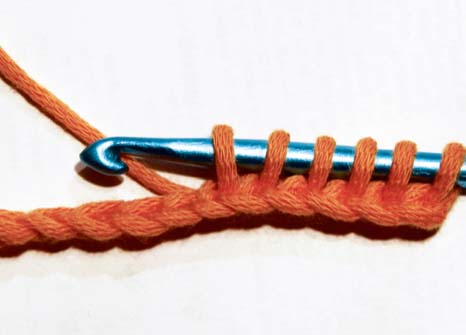
- When all the loops are on the hook, you should start to secure them. Leaving the knitting in the original position, you should grab and pull the thread through the last 2 loops. Each time knitting 2 loops, you need to go through the entire row. Ultimately, 1 loop will remain.

- Once you have finished a row, there is no need to turn the piece over.
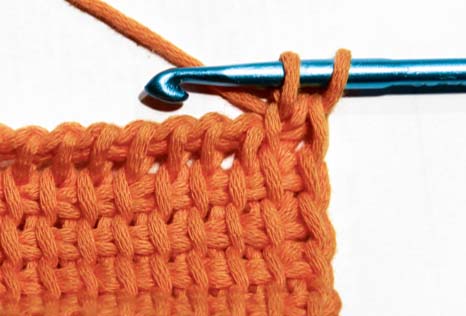
- The next row will be straight again. From this point on, you no longer need to make a lifting VP at the beginning of the rows. To pick up the loops in a row, you need to pass the head of the hook under the vertically located thread of the lower row and pull the thread out. The loops of the row should not be knitted - they should remain on the hook.

- Having finished the straight row, you need to make a VP, after which you simultaneously knit it and the last loop of the straight row. Throughout the entire closing row, you will need to knit 2 sts, so that at the end there is only one left on the hook.

- You need to continue knitting the fabric, repeating points 5 and 6.
Tunisian crochet (patterns can be any) always starts with the same basic rows. Knitting patterns usually starts with the 2nd straight row and depends on where the hook goes in the lower rows and whether loops are added or decreased.
Peculiarity in making the left edge loop
The purpose of the edge loops on the left side of the fabric is to form an even and beautiful edge, so they should be done in a certain way. Having knitted the penultimate loop of the bottom row in a straight row, the hook must be inserted behind the first vertical thread of the bottom loop, then pass the hook between the two back vertical threads and, grabbing the working thread, pull out the loop.
It is important to ensure that the sizes of the right and left edge loops match, as this affects the appearance of the product.
Securing the loops
When the piece of the required size and shape is knitted, the knitting needs to be finished. The last row should be straight. It should be knitted similarly to a regular straight row, but each loop needs to be knitted. This means that the hook should be inserted behind the first vertical thread of the bottom loop, grab the working thread, and then knit two loops at once, having first made a yarn over. At the end of this row, there should be 1 loop left, which needs to be secured, and the thread cut.
Tunisian crochet in the round
Circular rows are used if you need to make a closed seamless fabric. A thing knitted in this way will be stronger when worn, look neater and knit faster. For mittens and hats, you can take a double-ended hook, and for, for example, a sweater - hooks connected with a fishing line. Also, circular knitting can be done on a Tunisian hook, but it must have a fishing line at the end.
How to cast on stitches?
You need to start with a traditional chain consisting of VP. The chain should be closed into a ring. Then you need to make a straight row, similar to how it is done in traditional Tunisian crochet - pulling the loop through the vertical thread of the loop from below.
Having reached the 1st loop of the circle, you should pull the loop of the straight row through it. Then, using a yarn over, knit two loops. Thus, you need to knit the entire row. At the end, 2 loops should remain.
To secure the circle and move on to the next row, you should widen the penultimate loop, then pull the hook out of 2 loops. It needs to be inserted through 2 loops in the horizontal walls. Next, you need to put the penultimate loop on the hook. If everything is done correctly, then 3 loops should remain. They all need to be knitted with a yarn over.
The circular row will be finished, but at the closure point an unsightly space will form between the outer loops, to remove it you should:
- pull out the loop, remove the hook,
- first insert the hook behind the outer vertical wall of the last loop of the circular row, then into the outermost burying loop of this row, then use your finger to put the removed loop on the hook and knit the loops on the hook. This completes the circular row. The next one should be knitted in the same way.
Fixing
Finish the work and secure the last row of loops by making a half-column. When the last loop remains, it should be secured and the thread cut off.
Tunisian crochet symbols and patterns
The most common symbols for loops in Tunisian knitting are:
| ⸰ | Air |
| ǀ | Straight Row Column |
| ᷈ | Closing |
The following may also be found in the diagrams: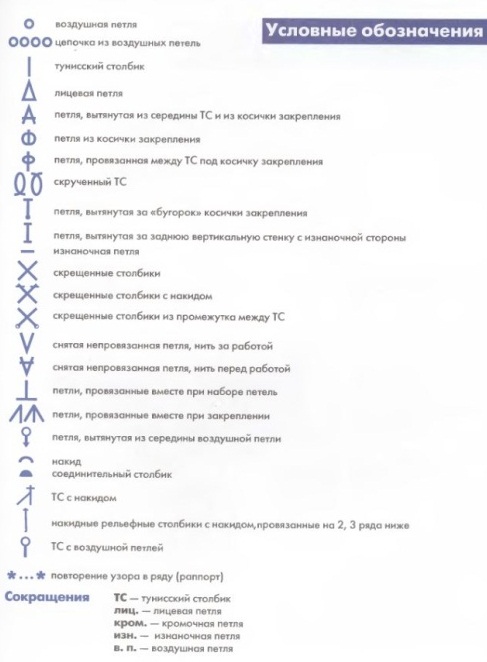
An example of a Tunisian crochet pattern would look like this: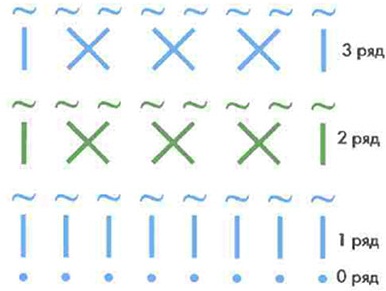
Tunisian crochet motifs and patterns
Despite the apparent simplicity of making loops in Tunisian crochet, there are a great many variations of patterns that can be obtained. The only thing that cannot be created in this technique is an openwork fabric. But if necessary, you can try to combine Tunisian crochet with regular crochet to get more interesting effects.
Leaf pattern (for contrast, the fabric is knitted with yarn of 2 colors):
The next pattern is a cage: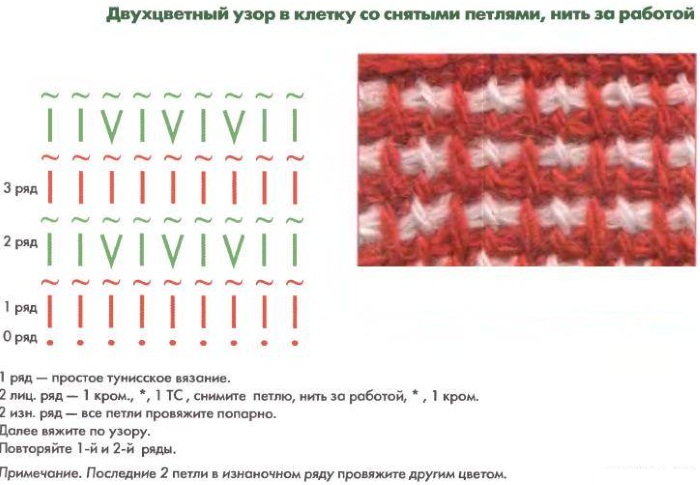
Embossed stripes can be made using the following pattern: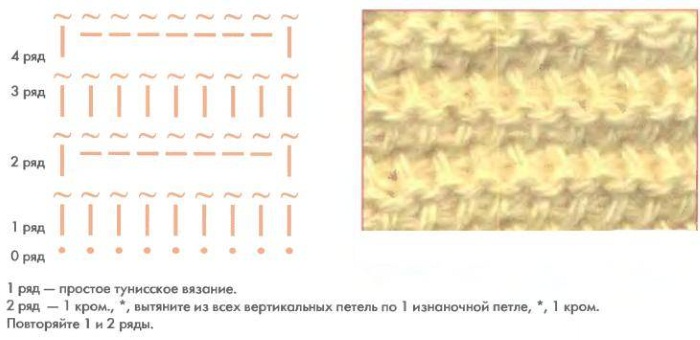
If you want to achieve the effect of a knitted fabric, then this motif will do:
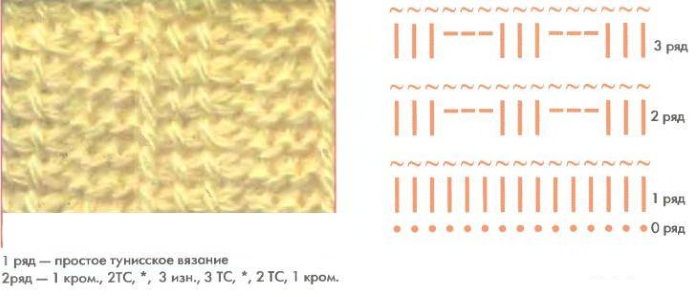
Tunisian Knitting
It is better to start mastering a new technique with simple but effective items. For example, you can make a brooch in the form of a bright flower or knit a vest for cool weather in a couple of evenings.
Decorative flowers
The flower petals are knitted together in a circle. A thin wire is knitted into the very edge of the petal, allowing the flower to hold the necessary shape. The middle is knitted separately. If you use "grass" yarn, you will not need to make additional stamens.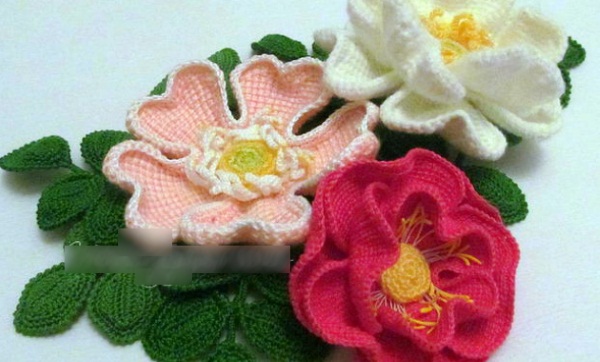
The leaves need to be knitted one by one, then knit them all into a branch.
After all the parts are connected, they are first assembled into a flower, and then a bouquet.
Plaid
Tunisian crochet method (any patterns will do), due to the density of the resulting fabric, is especially popular when making blankets. The size of the blue blanket with relief "bumps" is 155 * 93 cm. The blanket consists of alternating motifs: with bumps (turquoise-blue wool) and melange (knitted in 2 colors - gray-blue and light blue).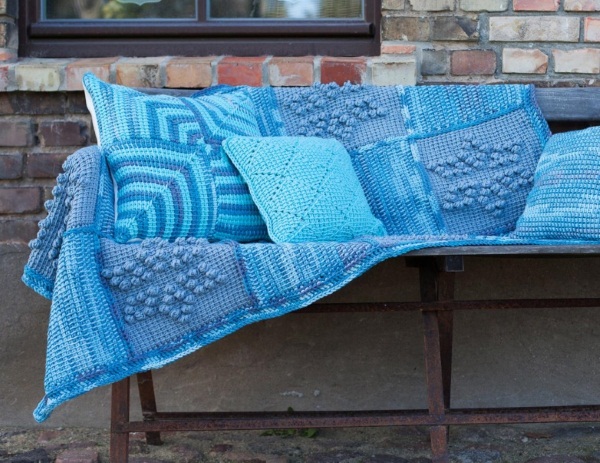
To work you will need:
- Yarn of 3 colors - turquoise-blue (800 g), gray-blue (800 g), light blue (400 g).
- Tunisian hook with fishing line at the end (No. 7).
Stages of work:
- The two-color square is knitted with the basic Tunisian pattern. To do this, you need to make a chain of 31 VP. The square will be 25 rows high. The mélange effect is achieved by alternating yarns of different colors.
- 1st row straight - blue yarn,
- 1st row closing – gray-blue yarn,
- 2nd row straight - gray-blue yarn,
- 2nd row closing – blue yarn,
- The 3rd and subsequent rows are a repetition of the 1st and 2nd rows.
- For a square with "bumps" arranged in a star shape, you also need to cast on 31 stitches with turquoise-blue yarn. To get the "bumps", you need to alternate the basic Tunisian knit with lush columns and knit according to the pattern.
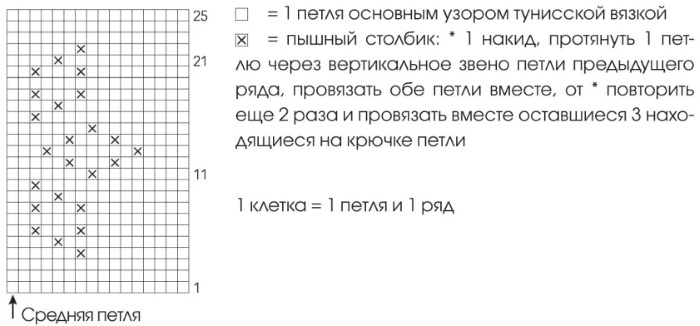
The diagram shows only half of the motif, the second part is done similarly, but in mirror image. The square should be 25 rows high.
- In total, you need to make 8 melange squares and 7 "with cones". You can connect them together using sc. In this case, you first need to connect the squares into stripes that will go along the blanket, and then knit the motifs across.
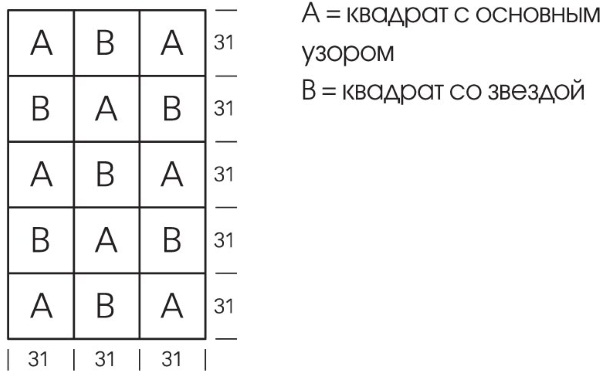
To make the blanket look finished, you need to tie it around the perimeter. The first row will be made of sc, then a row of dc. To prevent the corners from curling, when making them, you need to make several columns in the loop of the previous row.
Snood
The snood, knitted in the Tunisian technique, from plush yarn, is pleasant to the touch, has an original pattern and is lush. The dimensions of the finished product are 60 cm * 180 cm.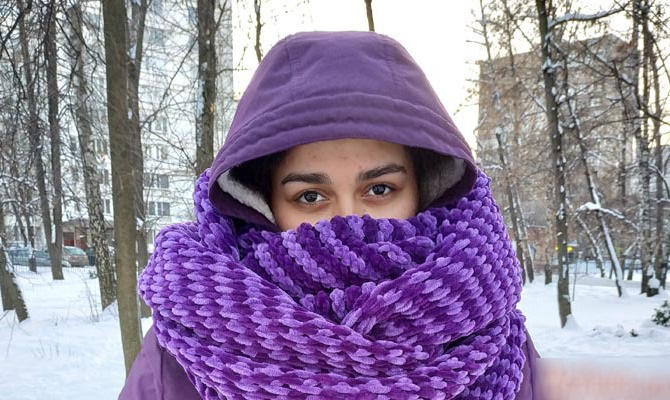
To work you will need:
- Plush yarn in 2 colors - 300 g each.
- Long hook No. 10.
Basic pattern.
- The pattern at the very beginning after the VP chain should be knitted according to the classic pattern. Since the product uses 2 colors of yarn, the 2nd color should be knitted at the stage of the closed row, when the last two loops of the row are knitted.
- When making the 2nd loop of the straight 2nd row, you need to pull out the thread, inserting the hook into the first space between the vertical walls through the horizontal wall. Then you should repeat the pattern until the end of the straight row. On the last 2 loops of the closing row, you need to change the yarn again to a different color.
- The next row must be knitted in the same way as the 2nd, but in the straight row the hook must be passed into the second space between the vertical walls.
- Continue knitting until the required length of the fabric is reached, alternating rows 2 and 3.
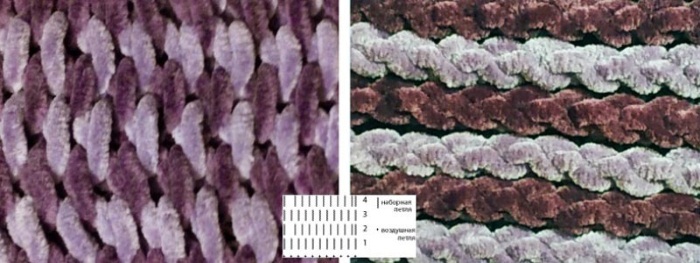
You need to start the work with a chain of VP, the length of which should be 60 cm. Then the work is done with the main pattern until the length reaches 180 cm. After this, the short edges of the fabric should be sewn. It is necessary to pay attention that the first and last row of the fabric should be knitted from threads of different colors.
House slippers with soles
To work you will need:
- Yarn in 3 colors (it is convenient to use leftover yarn for slippers).
- Long hook.
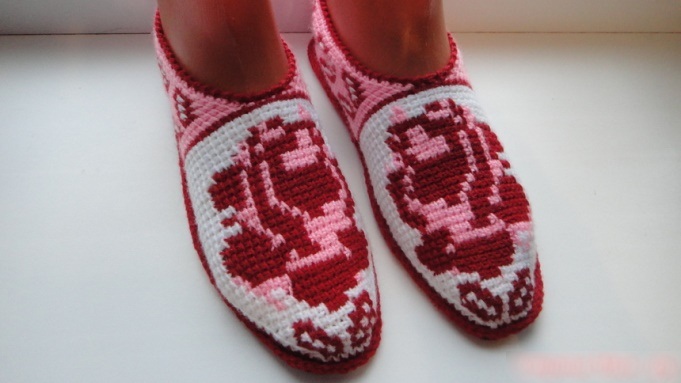
Execution of work:
- You need to cast on a chain of 15 stitches with pink yarn. Then you should knit the fabric using the standard Tunisian crochet pattern.
- The pattern starts from the 3rd row, so following the schematic drawing, you need to add a red thread.
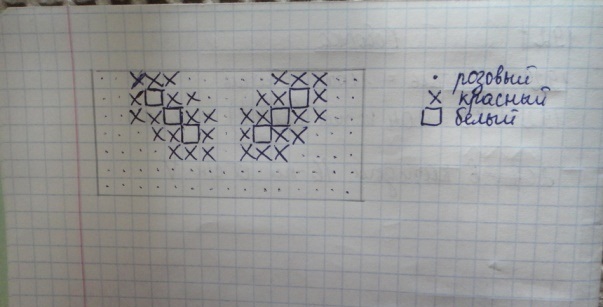
- This detail is the back and sides of the future slippers, so the pattern should be the same on the right and left. Depending on the size of the foot, you should make 3 or more pairs of leaves on each side, you can check by applying the detail to the foot during work. It should be up to the level where the foot connects to the ankle.
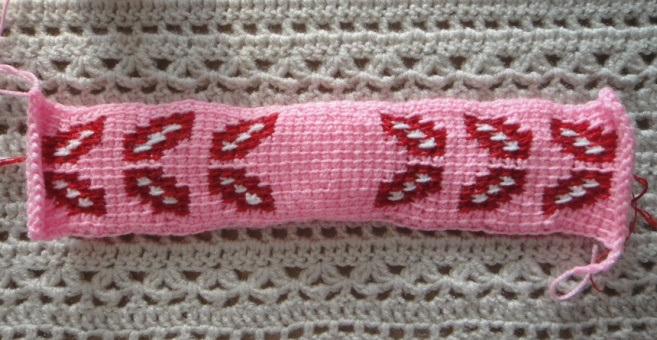

- After this, you need to move on to knitting the toe of the slippers. It is done according to the diagram
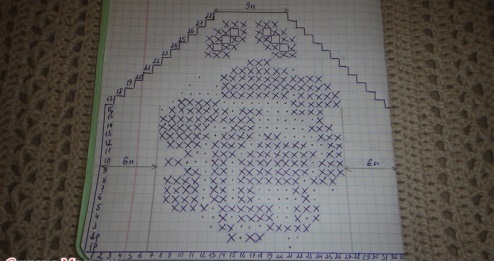
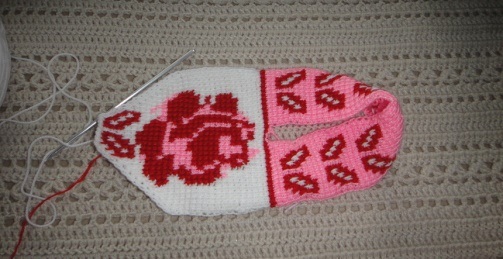
- Next, you need to cut out the sole from the felt. To do this, just take a ready-made insole of the right size and cut the felt according to it. Or you can try to find a suitable ready-made felt insole.
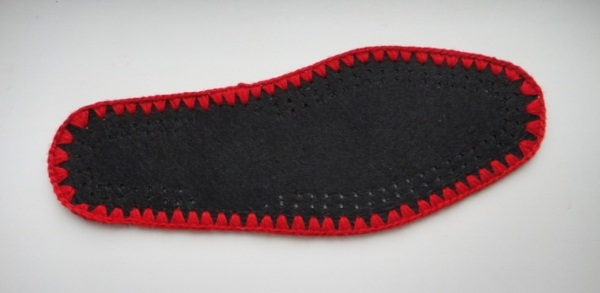
- First of all, the insole should be crocheted in a circle with a regular crochet hook. Even thin felt cannot be pierced with a crochet hook, so you can take a thick needle or an awl.

- To make sure the slippers are strong, you need to make sure that the distance from the edge to the puncture site is at least 1 cm, and the punctures are at a distance of 1-1.5 cm from each other.
- To tie the sole, insert the hook into the hole, grab the thread, pull it through the puncture so that a loop is formed on the hook, then grab the thread again and knit the loop. You need to make 4 of these stitches in each hole.
- Between the groups of columns you should make 1 VP.
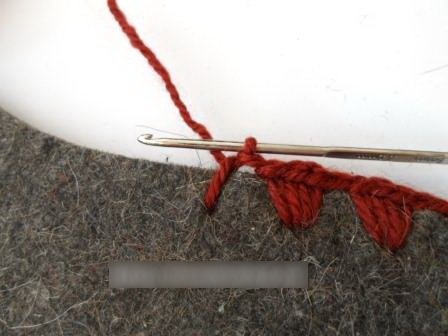
- Where the rounding begins, you need to add a 5th column to each hole.
- After the felt is tied, you need to “sew” the upper part of the slipper to the insole using sc.
Ethnic style vest
Tunisian crochet (the patterns will help you step by step to knit beautiful things no worse than those sold in stores) is suitable for outerwear and warm clothing. For those who are new to this type of knitting, it is recommended to choose a vest as the first product. The vest options are presented below.
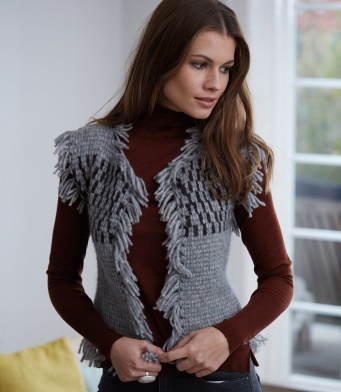
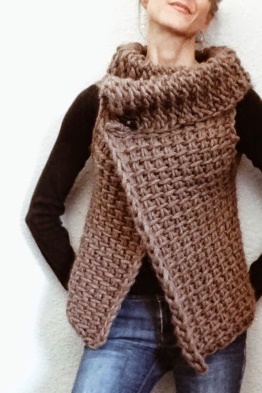
Tunisian crochet is interesting for its variety of patterns and motifs, the presence of great opportunities when knitting clothing and interior items. In addition, it requires less thread consumption, compared to classic crochet.
Author: Vorobyova Nadezhda
Tunisian Crochet Video
Tunisian Crochet for Beginners:

Thank you, interesting.
Hello! I want to tell you that you are a great girl!!!! It is wonderful that you are learning and teaching those who are interested. And